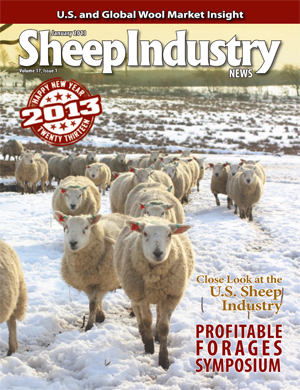Tri-State Meeting Looks at Wool and Lamb Markets
(Jan. 1, 2013) More than 330 attendees were registered at the first Tri-State Convention Nov. 9-11 which combined sheep producers from Idaho, Utah and Wyoming Wool Growers Associations. Among top concerns for the producers were the upcoming wool season and the lamb market situation.
Many U.S. wool buyers, warehousemen and wool processors gathered to discuss the 2012 wool season and to provide insight into the upcoming year. The panel consisted of Larry Prager and Scott Lammers, Center of the Nation Wool; Jason Banowsky, Lempriere USA; Mike Corn, Roswell Wool; Dan Gutzman, Pendleton Woolen Mills; Will Griggs, Utah Wool Marketing; Terry Martin and Rick Honaker, Anodyne Wool; and Bruce Barker, Great Plains Wool Co.
A general opinion was that the 2012 wool market was driven by a declining economic situation across Europe in conjunction with a warmer winter across the northern hemisphere, both resulting in disappointing garment sales last year. A larger inventory of garments resulted in less processing into fabrics, which ultimately resulted in less demand and lower trends in global raw-wool prices. The declining value of the U.S. dollar and the corresponding increase in the value of the Australian dollar was another contributing factor. It was also noted that the declining demand for goods forced China, the world’s largest wool processing country, to reduce overall production of finished garments.
Consensus among the buyers and warehousemen was that continued better preparation of U.S. wools would result in broader demand and a wider array of uses of U.S. wools, regardless of micron. Specifically, the continued removal and separation of bellies from fleeces, topknots, leg wool, tags and second cuts and any off colored wool due to stains. Buyers and processors continued to note the problems being experienced with black fibers in white wool, contamination of hair-sheep fibers and poly contamination. Excess branding paint and markers were also discussed along with suggestions for handling paint on cold days, application recommendations (keep brands to 4 mm or less) and the axiom that “ less is better” when applying paint.
The panel expressed the need for a larger supply of wool to meet the demand. Reduced supplies from declining sheep numbers have resulted in higher overhead costs for all segments of the wool industry. Due to the large volume of wool needed for processors to minimize costs, any problems or issues that occur with the wool results in higher costs.
It was reiterated that developing a plan with the shearing crew can reduce contamination as well as decrease the stress for the sheep and the labor during harvest. Making contact with the buyer or warehouse representative to discuss potential wool outlets can also assist in proper wool preparation.
A lamb market situation panel made up of speakers representing various facets of the lamb marketing industry was also one of the highlights.
“If you look back to 2009, we had fairly stable markets, we had good demand and good prices, and everyone was recovering from the 2008 economic crash – things were looking pretty good,” commented Frank Moore of Mountain States Lamb Cooperative. “As we started into 2010, we were trying to increase the demand for lamb, and we were getting some takers. All of a sudden, the problem was there wasn’t enough lamb.
If we are going to grow our business and grow demand, we need more production,” he added. “We have to be able to provide the product.”
Although backed up lamb markets and dropping prices dominated most of 2012, Mike Harper, lamb feeder from Colorado, said they were able to clean out the old crops by the third week of October.
“We’re back to handier weights now, still heavy, but a whole lot better than where we were,” he said. “On advantage – if there is any advantage – of the drought is that it gave us a little break on our feeder weights this fall.”
Jeff Davis with Superior Farms explained the market trends the industry has experienced over the past two years.
“There were 51 million pounds of lamb sold in the 12-month period ending August 2010 – a 2.4 percent increase year over year at retail.
The first signs of weakness started to show in August 2010, with sales down 5.4 percent on the quarter, but things were extremely current,” he continued. “When I fast-forward to November 2011, after one full year of high prices, there was only 41.3 million pounds of lamb at retail.”
This decrease in sales occurred in many proteins, and by 2011 the market was down 16.7 percent for the year and 17 percent for the quarter.
“In 2010, $285 million went across the retail counter, and $280 million in 2011,” Evanston continued. “We know prices went through the roof, and in an industry that sells this much lamb, the retailers got $5 million less across their counters. That has pretty significant impacts.”
As of August 2012, he said the carcass market had stabilized and lamb is down 9 percent, which is similar to other proteins – beef sales down 8.5 percent. However, the amount of lamb going across the retail counter is still at just less than 40 million pounds, which is still significantly lower than several years ago.
As for imported product, Evanston said that Australia is increasing their market share – in 2011 their imports to the United States grew by 6 percent.
Both Evanston and Kevin Quam with JBS USA’s Lamb Division commented that lamb consumption is down.
Quam noted, “A year ago, we needed between 22 and 24 live loads of fat lambs each week. Since late May or early June, we are only killing between 10 and 12 loads. I’ve not seen any improvement in demand on the carcass side.”
Commenting on the large freezer inventory, Quam said, “Some of it is starting to move to retail shelves, but it will take a while to sell that product.”


